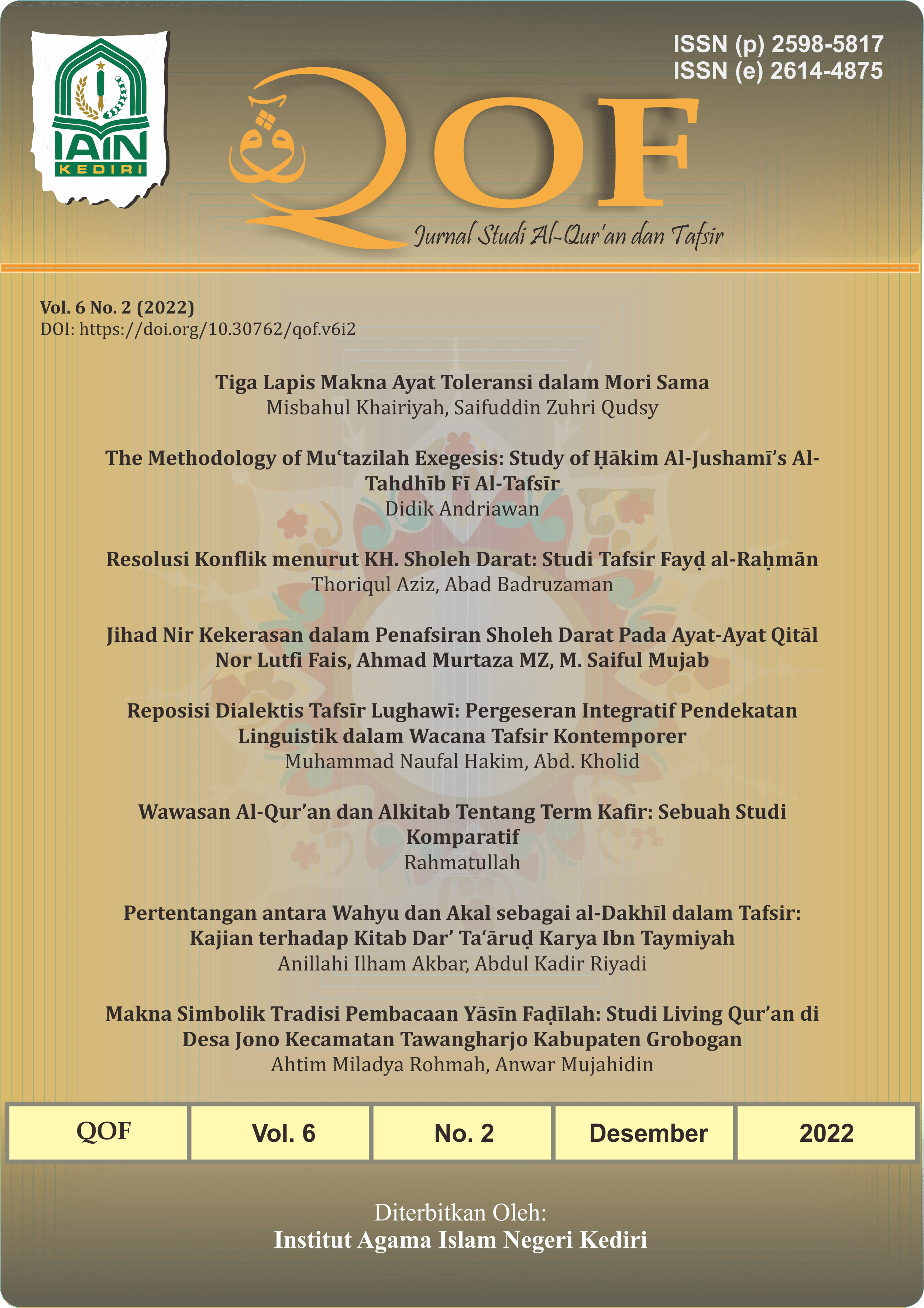Reposisi Dialektis Tafsīr Lughawī: Pergeseran Integratif Pendekatan Linguistik dalam Wacana Tafsir Kontemporer
DOI:
https://doi.org/10.30762/qof.v6i2.275Keywords:
Tafsīr Lughawī, Exegesis Style, Exegesis MethodAbstract
This article aims to re-read the position of tafsīr lughawī in contemporary interpretation discourse. The background of the research is the fact that contemporary interpretation methodologies have emerged which seem to nullify linguistic reviews in interpretation. Using the critical-analytic method and the historical-philosophical approach, three points are examined: 1.) typology which includes book mapping, commentator, and interpretation methods; 2.) genealogy from its inception to its development; 3.) existential reading of tafsīr lughawī. This study infered 20 mapped tafsīr lughawī book not only use the manhaj al-lughawī but also the manhaj al-adabī, al-balāghī, and al-bayānī. The genealogy of the interpretation of the Qur’ān using a linguistic approach has existed since the time of the Prophet, the Companions, and the Tabiin, then continued until the emergence of interpretation books using lughawī style since the 2nd century Hijri. The main characteristic of tafsīr lughawī is the use of al-‘ulūm al-‘arabiyyah as the interpretating device, such as qawā‘id al-lughah (naḥw and ṣarf), ‘ulūm al-balāghah (ma‘ānī, bayān, and bādī‘), qiraah, and Jāhili Arabic poetry. In contemporary interpretation discourse, tafsīr lughawī is repositioned, in which the rules of interpretation are still used, but the lughawī style is no longer the dominant one for its integration-interconnection with other disciplines to produce a more in-depth and contextual interpretation.
Downloads
References
‘Ak, Khālid ‘Abd al-Raḥmān al-. Uṣūl al-Tafsīr wa Qawā‘iduhu. cet. 2. Bayrūt: Dār al-Nafāis, 1986.
Abduh, Muḥammad, dan Muḥammad Rashīd Riḍā. Tafsīr al-Qur’ān al-Ḥakīm. cet. 2. Kairo: Dār al-Manār, 1947.
Aṣfihānī, al-Rāghīb al-. Mufradāt Alfāẓ al-Qur’ān. cet. 4, Bayrūt: Dār Al-Syāmiyyah, 2009.
Balkhī, Abū al-Ḥasan Muqattil b. al-Sulaymān b. Bashīr al-Azdī al-. al-Wujūh wa al-Naẓāir fī al-Qur’ān al-‘Aẓīm. cet. 2. Baghdād: Maktabah al-Rashid, 2011.
Baried, Siti Baroroh, dkk. Pengantar Ilmu Filologi. cet. 1. Jakarta: Pusat Pembinaan dan Pengembangan Bahasa, 1985.
Dhahabī, Muḥammad Ḥusain al-. al-Tafsīr wa al-Mufassirūn. Kairo: Maktabah Wahbah, 1976.
Garwan, Muhammad Sakti. “Relasi Teori Double Movement dengan Kaidah al-Ibrah bi Umumil-Lafdz la bi Khusus as-Sabab dalam Interpretasi QS. al-Ahzab [33]: 36-38.” Jurnal Ushuluddin 28, no. 1 (2020): 59-70. http://dx.doi.org/10.24014/jush.v28i1.8103
Ghalāyāynī, Musṭafā al-. Jāmi’u al-Durūs. Bayrūt: al-Maktabah al-‘Aṣriyyah, 1984.
Hakim, Muhammad Naufal. “Ta’wīl Tafsir Periode Modern: Telaah Tafsīr al-Marāghī Karya Ahmad Musthāfā.” Jurnal al-Fath 15, no. 2 (2022): 89-118. https://doi.org/10.32678/alfath.v15i2.5275
Iyāzī, Muḥammad ‘Alī. al-Mufassirūn Hayātuhum wa Manhajuhum. cet. 1. Teherān: Wizārah al-Thaqāfah wa al-Irshād al-Islāmī, 1895.
Jansen, J. J. G. Diskursus Tafsir al-Qur’an Modern, terj. Syarif Hidayatullah dan Hairussalim. cet. 1. Yogyakarta: Tiara Wacana Yogya, 1997.
Kholid, Abd. Corak Interpretatif Teologis Wahbah al-Zuḥailī. cet. 1. Jombang: Fakultas Pertanian Universitas KH. A. Wahab Hasbullah, 2022.
Kurzman, Charles. Liberal Islam a Sourcebook. New York: Oxford University Prees, 1998.
Maḥallī, Jalāl al-Dīn Muḥammad b. Aḥmad al- dan Jalāl al-dīn ‘Abd Raḥmān b. Abī Bakr al-Suyūṭī, Tafsīr al-Qur’ān al-‘Aẓīm. Surabaya: Dār al-’Ilm, 2012.
Mahfudz, Ali. “Tafsir al-Lughawī: Histori dan Penerapannya.” el-Furqania: The Ushuluddin Journal and Islamic Sciences 4, no. 2 (2018): 184–201. https://doi.org/10.54625/elfurqania.v4i02.3294
Muhammad, Abdurrahman Muhammad. Penafsiran al-Qur’an dalam Pespektif Nabi Muhammad SAW. terj. Rosihon Anwar. cet. 1. Bandung: CV Pustaka Setia, 1999.
Mūsā, Hārūn b. al-Wujūh wa al-Naẓāir fī al-Qur’ān al-Karīm. Baghdād, 1988.
Musaddad, Endad. “Metode Tafsir Bint al-Syathi: Analisis Surat al-Dluha”. al-Qalam 20, no. 98–99 (2003), 51-72. https://doi.org/10.32678/alqalam.v20i98-99.636
Mushodiq, Muhamad Agus. “Majaz al-Quran Pemicu Lahirnya Ilmu Balaghah: Telaah Pemikiran ‘Ali ‘Asyri Zāid”. an-Nabighoh 20, no. 01 (2018): 45–62. https://doi.org/10.32332/an-nabighoh.v20i01.1133
Mustaqim, Abdul. “Tafsir Linguistik (Studi atas Ma’anil Qur’an Karya al-Farra’)”. QOF: Jurnal Studi al-Qur’an dan Tafsir 3, no. 1 (2019): 1-11. https://doi.org/10.30762/qof.v3i1.722
Quṭb, Sayyid. Fī Dzilāl al-Qur’ān. Bayrūt: Dār al-Syurūq, 1972.
Riḍāī, Muḥammad ’Alī al-. Manāhij al-Tafsīr wa Ittijāhātuhu Dirāsah Muqāranah fī Manāhij Tafsīr al-Qur’ān al-Karīm. cet. 3. Bayrūt: Markaz al-Ḥaḍārah li Tanmiyah al-Fikr al-Islāmī, 2011.
Ridwan, M. K. “Metodologi Penafsiran Kontekstual; Analisis Gagasan dan Prinsip Kunci Penafsiran Kontekstual Abdullah Saeed”. Millati: Journal of Islamic Studies and Humanities 1, no. 1 (2016): 1-22. https://doi.org/10.18326/mlt.v1i1.1-22
Rosa, Andi. Tafsir Kontemporer: Metode dan Orientasi Modern dari Para Ahli dalam Menafsirkan Ayat al-Qur’an. cet. 2. Banten: Depdikbud Banten Press, 2015.
Rūmī, Fahd b. ‘Abd al-Raḥmān b. Sulaymān al-. Buḥuth fī Uṣūl al-Tafsīr wa Manāhijuhu. t.t: Maktabah al-Tawbah, 1998.
Rūmī, Fahd b. ’Abd al-Raḥmān b. Sulaymān al-. Ittijāhāt al-Tafsīr fī al-Qarni al-Rābi’ ’Asyr. cet. 3. Bayrūt: Muasasah al-Risalah, 1997.
Sahidah, Ahmad, God, Man, and Nature: Perspektif Toshihiko Izutsu tentang Relasi Tuhan, Manusia, dan Alam dalam al-Qur’an. cet. 1. Yogyakarta: IRCiSoD, 2018.
Setiawan, Nur Kholis. al-Qur’an Kitab Sastra Terbesar. cet. 2. Yogyakarta: eLSAQ Prees, 2006.
Shāṭi’, Āishah ‘Abd al-Raḥmān Bintu al-. al-Tafsīr al-Bayān li al-Qur’ān al-Karīm. cet. 5. Mesir: Dār al-Ma‘ārif, 1968.
Shihab, Muhammad Quraish. Kaidah Tafsir: Syarat, Ketentuan, dan Aturan yang Patut Anda Ketahui dalam Memahami Ayat-ayat al-Qur’an. cet. 1. Jakarta: Lentera Hati, 2019.
Syafrijal. “Tafsir Lughawi.” al-Ta lim Journal 20, no. 2 (2013): 421–430. 10.15548/jt.v20i2.39
Syamsuddin, Sahiron, dkk., Pendekatan Ma‘nā-cum-Maghzā atas al-Qur’ān dan Hadis: Menjawab Problematika Sosial Keagamaan di Era Kontemporer. cet. 1. Yogyakarta: Lembaga Ladang Kata & Asosiasi Ilmu Alquran & Tafsir se-Indonesia, 2020.
Ṭayyār, Musā‘id b. Sulaymān b. Nāṣir al-. al-Tafsīr al-Lughawī li al-Qur’ān al-Karīm. cet. 1. Riyāḍ: Dār Ibn Jawzī, 2002.
Wahida, Besse, Khaerun Nisa Nuur, and Ibnu Hajar Ansori. "TRACING ENTITIES OF ARABIC IN THE QUR’AN." Jurnal Adabiyah 21.1 (2021): 1-25.
Wahyudi. “al-Wujuh wa al-Nazhair dalam Alquran Perspektif Historis.” AL-QUDS: Jurnal Studi Alquran dan Hadis 3, no. 1 (2019): 21-36. http://dx.doi.org/10.29240/alquds.v3i1.575
Downloads
Published
How to Cite
Issue
Section
License
Copyright (c) 2022 Muhammad Naufal Hakim, Abd. Kholid

This work is licensed under a Creative Commons Attribution 4.0 International License.
The use of the articles will be governed by the Creative Commons Attribution license as currently displayed on Creative Commons Attribution 4.0 International License.


